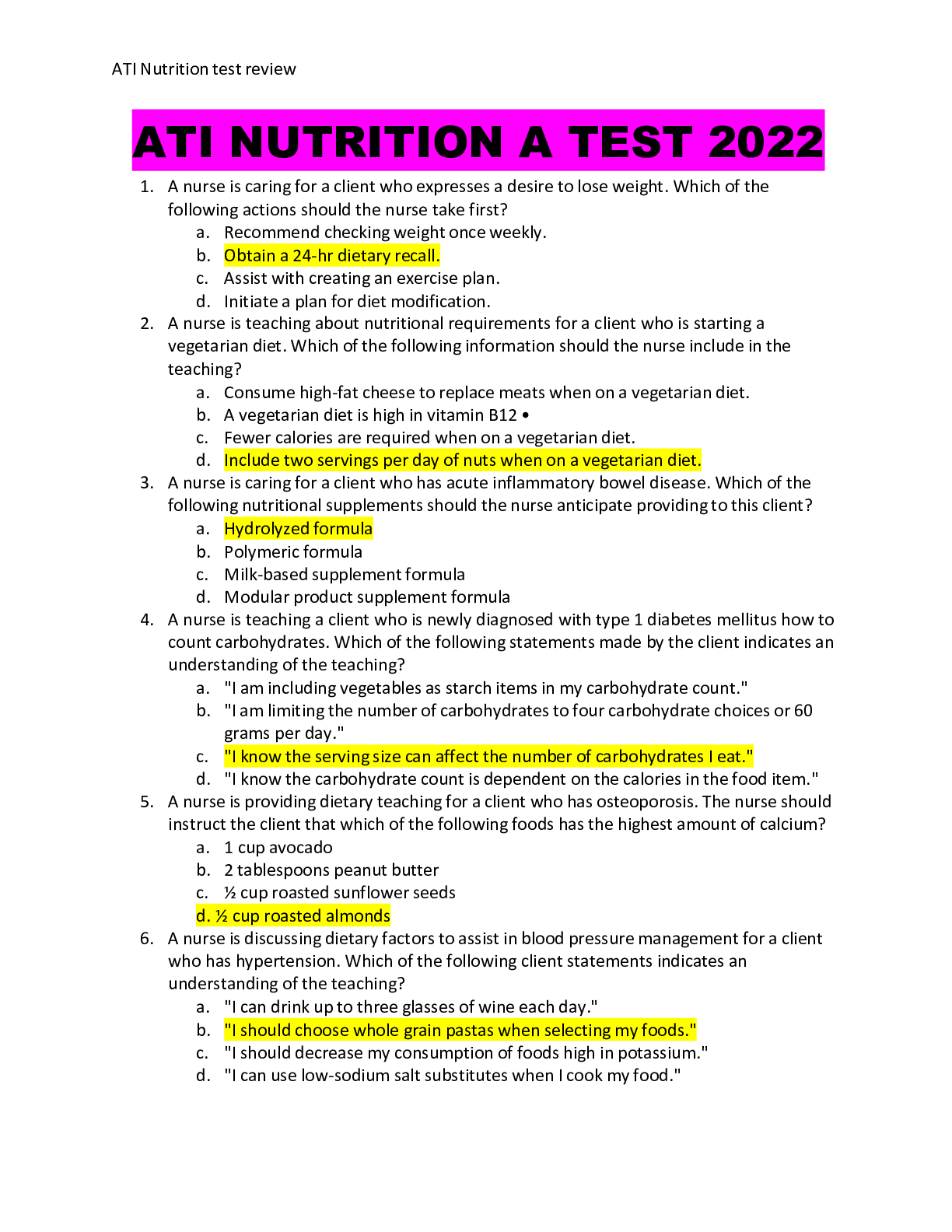*NURSING > QUESTIONS & ANSWERS > Exam-4-capstone questions and answers already graded A (All)
Exam-4-capstone questions and answers already graded A
Document Content and Description Below
Question: The client has been working on weight loss for 8 months and has been successful in losing 35 lbs (15.9 kg). The client is now entering the maintenance phase of the health promotion plan. ... Which strategies are important for the nurse to emphasize as the client enters this phase? You answered this question Correctly 1. On-going support from weight-loss program personnel. 2. Periodic weigh-ins with the nurse. 3. Discontinue programmatic exercise plan. 4. Relapse prevention plan. 5. Continued peer support. Rationale Strategies 1., 2., 4. & 5. Correct: The person must have ongoing support to prevent a relapse. The weigh-ins increase accountability for prolonged behavioral change. Anytime that a new behavior is instituted, there is a chance that the person will return to old habits. Having a plan in place may help the person to stay on track. Ongoing peer support can be very helpful as the client continues in the maintenance phase. 3. Incorrect: Programmatic exercise, although reduced in frequency perhaps, should still be available. If this is taken away or reduced too much, the client may return to old habits. Question: Which client in the Labor, Delivery, Recovery, and Postpartum Unit (LDRP) should the nurse see first? You answered this question Correctly 1. Primipara at 39 weeks gestation, who is dilated to three centimeters and at minus two station who states, "I think my water just broke." 2. Multigravida at term who is dilated to six centimers and at minus one station with moderate contractions every five to ten minutes. 3. Primipara at 38 weeks gestation who is dilated to five centimeters and at zero station with strong contractions every four minutes. 4. Multigravida at 36 weeks gestation with pregestational diabetes in for a biophysical profile for fetal well being. Rationale Strategies 1. Correct: Minus two station is high with the presenting part not engaged. This client is at high risk for prolapsed cord, which would require relieving pressure on the cord and emergency cesarean delivery. 2. Incorrect: Contractions are not close enough for this client to be an emergent situation. Also, since this is a multigravida client and not fully dilated yet, she is not a high risk client. 3. Incorrect: This client is in the active phase of labor, but there is much work to be done before she is fully dilated and engaged for delivery. 4. Incorrect: This client is not in labor and is a non-emergent client, particularly compared to client #1. Question: The nurse is preparing to discharge a client who has been placed on tranylcypromine. The nurse teaches the client about food to avoid while taking this medication. What food choice by the client confirms appropriate understanding of the teaching? You answered this question Correctly 1. Cottage cheese 2. Salami 3. Baked chicken 4. Potatoes Rationale Strategies 2. Correct: The client taking a monoamine oxidase inhibitor (MAOI) such as tranylcypromine should avoid foods rich in tyramine or tryptophan. These include: cured foods, those that have been aged, pickled, fermented, or smoked. These can precipitate a hypertensive crisis. 1. Incorrect: Clients taking MAOIs can eat cottage cheese in reasonable amounts. 3. Incorrect: Clients taking MAOIs can eat baked chicken. 4. Incorrect: Clients taking MAOIs can eat potatoes. Question: What task by the RN should be performed first? You answered this question Correctly 1. Changing a burn dressing that is scheduled every four hours. 2. Administering scheduled IV antibiotic. 3. Teaching a new diagnosed diabetic about diet and exercise. 4. Assessing a newly admitted client. Rationale Strategies 4. Correct: The admit assessment should be done first. It is important to initiate the assessment and physical exam within one hour of being admitted to the unit or floor. The assessment and plan of care should be completed within 8 hours of admission. 1. Incorrect: The other clients' needs are important, but are scheduled and established in a routine. These routines can be continued once the new client’s assessment has been completed. 2. Incorrect: This is not a priority based on the information in the question. The scheduled IV antibiotic administration can be administered within the appropriate time frame. 3. Incorrect: A newly diagnosed diabetic is not always ready for teaching, so this is not priority. The nurse should identify when the client is ready to learn. This teaching session can occur prior to or after assessing the new client. Question: A client is admitted to the intensive care unit after overdosing on meperidine. What is the nurse's first priority? You answered this question Incorrectly 1. Maintain continuous cardiac monitoring. 2. Administer naloxone hydrochloride 0.4 mg IV every 2-3 minutes prn. 3. Provide alprazolam 0.25 mg PO PRN. 4. Initiate intravenous fluid resuscitation with lactated ringers at 125 mL/hr. Rationale Strategies 2. Correct: The respiratory status of the client takes priority. The administration of naloxone will block the opioid, initiating a reversal of the central nervous system (CNS) and respiratory depression. 1. Incorrect: Continuous cardiac monitoring is appropriate, however, airway takes priority. 3. Incorrect: Alprazolam will worsen respiratory depression. Alprazolam is a benzodiazepine. The action of this drug may depress the CNS. 4. Incorrect: IV fluids will be initiated, but airway takes priority. Question: A client is admitted to the medical unit with an acute onset of fever, chills and RUQ pain. Vital signs are: T 99.8°F (37.7°C), P 132, RR 34, B/P 142/82. ABG results are: pH- 7.53, PaCO2 30, HCO3 22. The nurse determines that this client is in what acid/base imbalance? You answered this question Correctly 1. Respiratory acidosis 2. Respiratory alkalosis 3. Metabolic acidosis 4. Metabolic alkalosis Rationale Strategies 2. Correct: This client has a severe infection. Hyperventilation due to anxiety, pain, shock, severe infection, fever, and liver failure can lead to respiratory alkalosis. pH > 7.45, PCO2 < 35, HCO3 normal. 1. Incorrect: Not acidosis with hyperventilation and pH of 7.53. 3. Incorrect: Not a metabolic related acid/base imbalance since the HCO3 is in normal range and is not acidosis. 4. Incorrect: Not a metabolic related acid/base imbalance since the HCO3 is in normal range. Question: A new mother calls the clinic and tells the nurse, “I don’t have any help taking care of my 3 week old baby. I don’t know what to do. I just feel like I can’t take care of him anymore. I wish I never had him sometimes. Maybe then my husband would spend more time at home.” What would be the nurse's best response? You answered this question Correctly 1. "You are experiencing maternity blues, which will go away on its own." 2. "You are just tired. Tell your husband that you need his help." 3. "Come to the clinic now so that we can help you." 4. "Have you thought about getting a family member to help with the baby?" Rationale Strategies 3. Correct: This client is exhibiting signs of postpartum psychosis. Post partum psychosis is characterized by depressed mood, agitation, indecision, lack of concentration, guilt, and an abnormal attitude toward bodily functions. There is a lack of interest in or rejection of the baby, or a morbid fear that the baby may be harmed. Risks of suicide and infanticide should not be overlooked. 1. Incorrect: Maternity blues includes tearfulness, despondency, anxiety and subjectivity with impaired concentration. 2. Incorrect: This ignores a potentially life-threatening problem. The client is not just tired. 4. Incorrect: This ignores a potentially life-threatening problem. Assume the worse. Think about the safety of mom and baby. Question: A client has a prescription for digoxin 0.125 mg IV push every morning. Prior to administering digoxin, the nurse notes that the digoxin level drawn this morning was 0.9 ng/mL. Which action would be most important for the nurse to take? You answered this question Incorrectly 1. Administer the digoxin. 2. Hold the digoxin. 3. Notify the primary healthcare provider. 4. Repeat the digoxin level. Rationale Strategies 1. Correct: This is a normal digoxin level. The nurse would administer the prescribed digoxin. The therapeutic serum levels of digoxin range from 0.5 to 2 ng/mL. 2. Incorrect: This is a normal digoxin level. The nurse would administer the prescribed digoxin. 3. Incorrect: There is no need to notify the primary healthcare provider of a normal digoxin level. 4. Incorrect: There is no need to repeat a normal laboratory value. Question: Which member of the multi-disciplinary team oversees and coordinates the healthcare delivery process and organizes the delivery of healthcare services to the client? You answered this question Correctly 1. Clinical nutritionist 2. Primary nurse each shift 3. Primary healthcare provider 4. Case manager Rationale Strategies 4. Correct: An important role of the case manager in the multi-disciplinary team care approach is coordination of client care. The case manager oversees the process of healthcare delivery and organizes and coordinates the delivery of healthcare services to the client. 1. Incorrect: The clinical nutritionist is a member of the multi-disciplinary team, but does not coordinate and organize the delivery of care outside of the client's nutritional needs. 2. Incorrect: The primary nurse each shift develops and executes the plan of care for the client, but is not the organizer and coordinator of all the services to the client. 3. Incorrect: The primary healthcare provider is a member of the multi-disciplinary team, but is responsible for prescribing healthcare for the client, not organizing the services. Question: The unlicensed assistive personnel (UAP) reports to the nurse that a client with Alzheimer's has been walking into rooms on the unit and stating, "This is my room, so get out!" What is the best instruction the nurse can give to the UAP? You answered this question Correctly 1. Calmly sit with the client and have the client repeat the room number at frequent intervals. 2. Have the client remain in the room so the client can become familiar with it. 3. Place a sign on the client's door that clearly has the client's name so the client can identify it. 4. Hang a familiar object on the door to enhance room recognition. Rationale Strategies 4. Correct: A client with Alzheimer's is likely to recognize a familiar object before reading the name on the door. 1. Incorrect: You can make the client repeat the room number over and over, but he or she will not remember it particularly since it is short-term current memory. This is the part of memory that goes first with the Alzheimer's client. 2. Incorrect: Stay in your room until you get used to it? No, this is non- therapeutic for a client with Alzheimer's and could increase their confusion and moody behavior. [Show More]
Last updated: 1 year ago
Preview 1 out of 80 pages
Instant download

Buy this document to get the full access instantly
Instant Download Access after purchase
Add to cartInstant download
Reviews( 0 )
Document information
Connected school, study & course
About the document
Uploaded On
Sep 22, 2021
Number of pages
80
Written in
Additional information
This document has been written for:
Uploaded
Sep 22, 2021
Downloads
0
Views
58

.png)
.png)
.png)
.png)
.png)
.png)
.png)
.png)
.png)
.png)
.png)

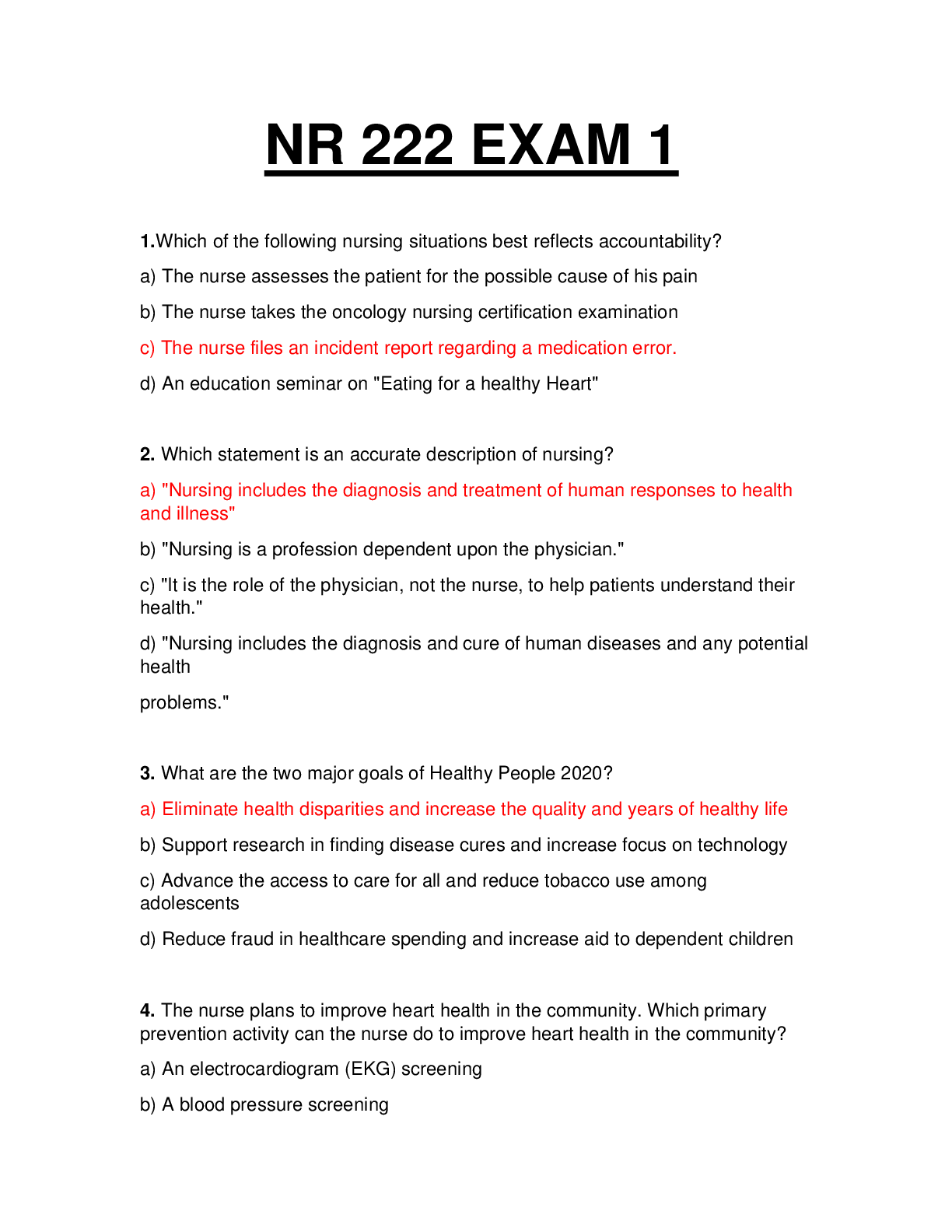



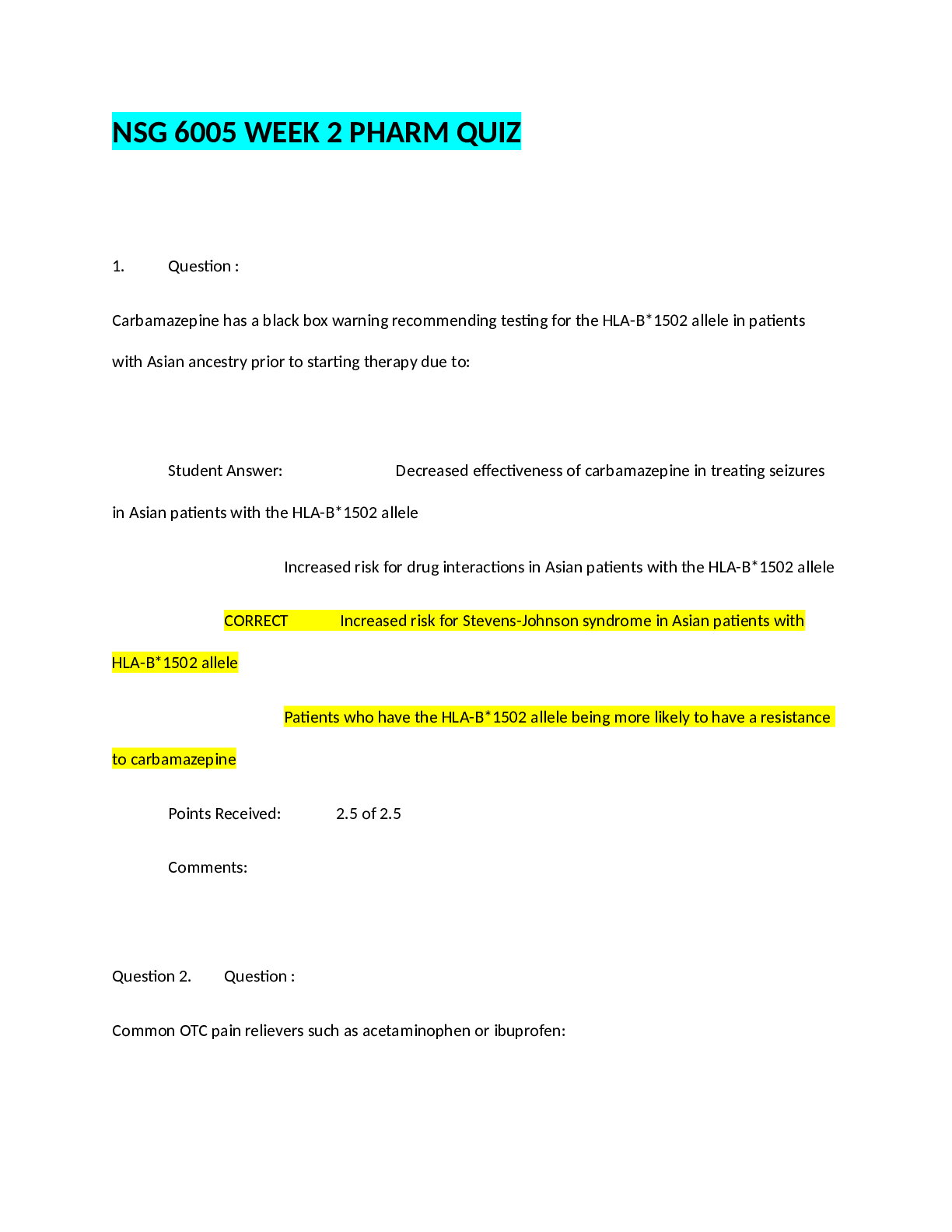


.png)
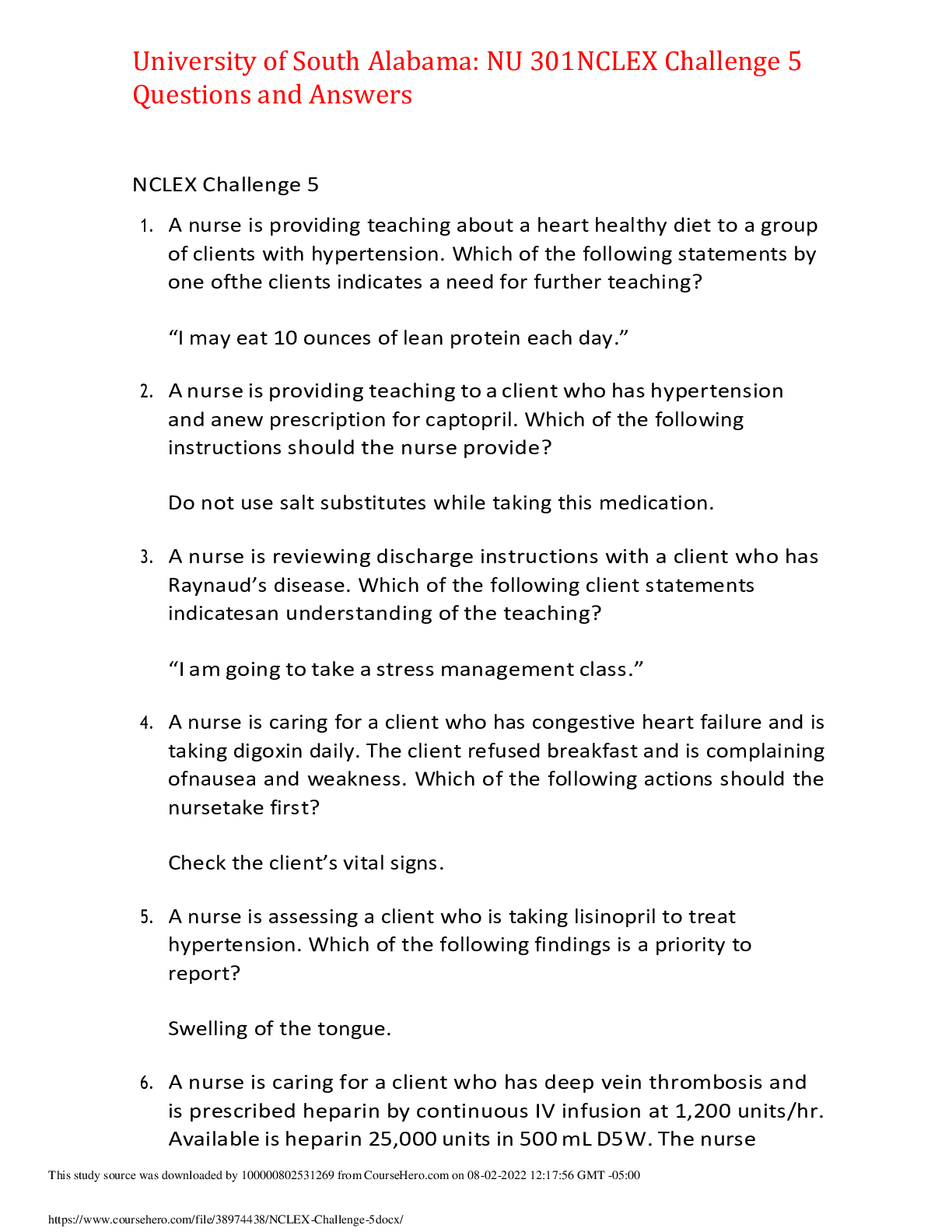
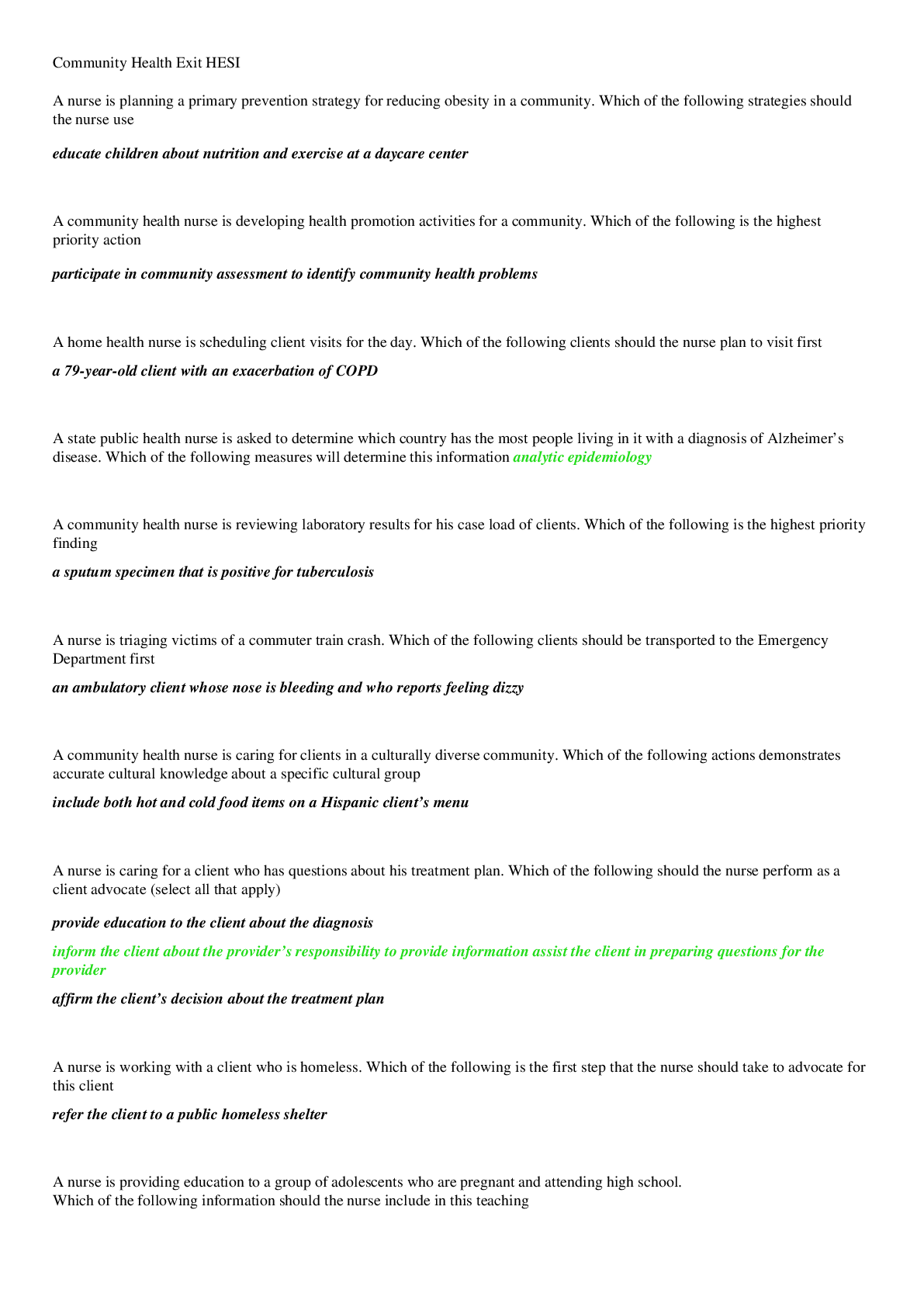
.png)
